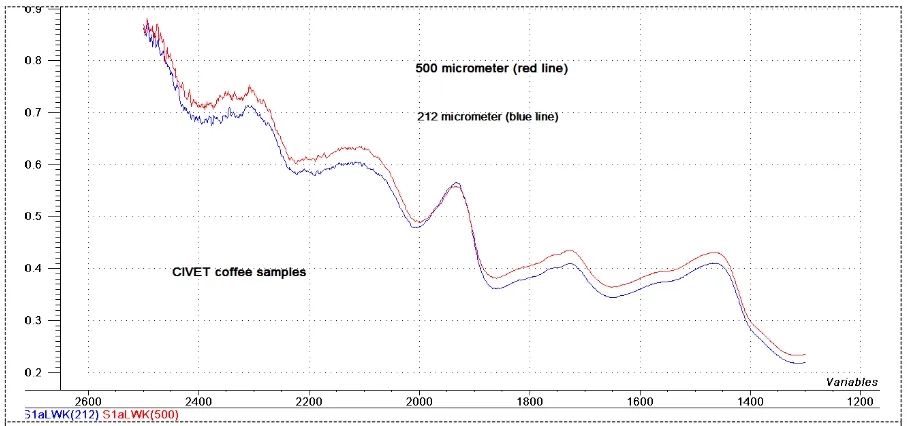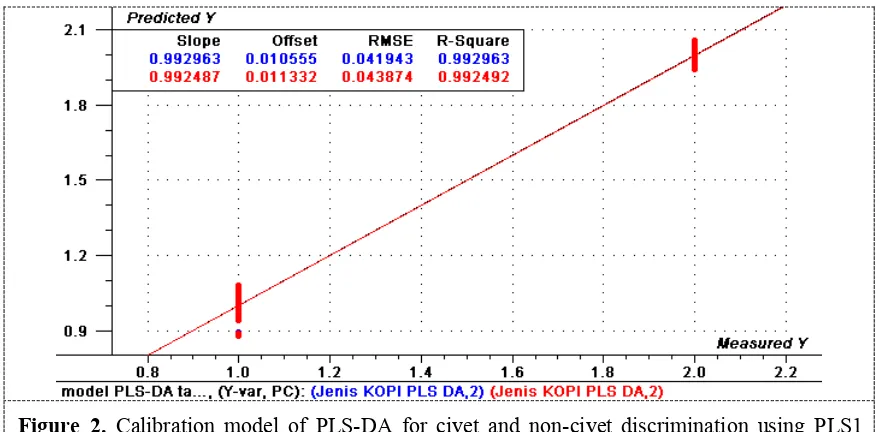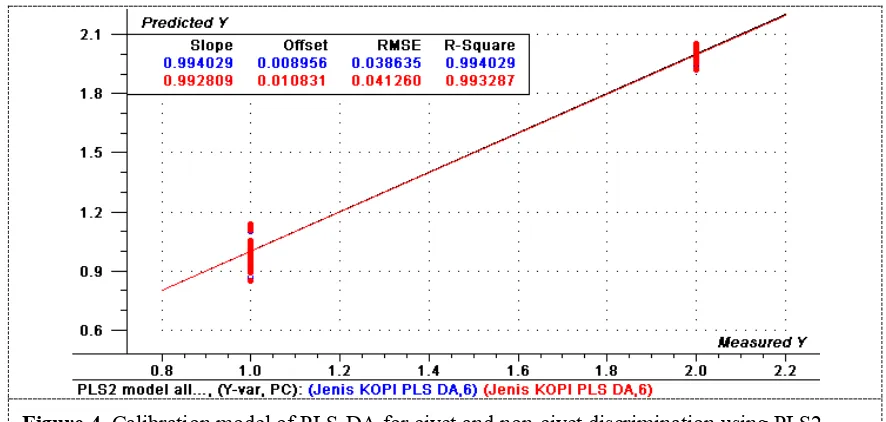IOP Conference Series: Materials Science and Engineering
PAPER • OPEN ACCESS
The feasibility of using explicit method for linear
correction of the particle size variation using NIR
Spectroscopy combined with PLS
2
regression
method
To cite this article: M Yulia and D Suhandy 2018 IOP Conf. Ser.: Mater. Sci. Eng.334 012062
View the article online for updates and enhancements.
Related content
The Detection and Quantification of Adulteration in Ground Roasted Asian Palm Civet Coffee Using Near-Infrared Spectroscopy in Tandem with Chemometrics
D Suhandy, M Yulia, Y Ogawa et al.
-Rotating mirror method for measuring the visible and NIR spectrum of plasmas
Luis Bernal and Luis Bilbao
-Prediction of Caffeine Content in Java Preanger Coffee Beans by NIR
Spectroscopy Using PLS and MLR Method
I W Budiastra, Sutrisno, S Widyotomo et al.
1234567890‘’“”
3rd ICChESA 2017 IOP Publishing
IOP Conf. Series: Materials Science and Engineering 334 (2018) 012062 doi:10.1088/1757-899X/334/1/012062
The feasibility of using explicit method for linear correction of
the particle size variation using NIR Spectroscopy combined
with PLS
2regression method
M Yulia1,3
and D Suhandy2
1 Department of Agricultural Technology, Lampung State Polytechnic, Jl. Soekarno
Hatta No. 10, Rajabasa Bandar Lampung, 35144, Indonesia
2 Department of Agricultural Engineering, Faculty of Agriculture, The University of
Lampung, Jl. Prof. Dr. Soemantri Brojonegoro No.1, Bandar Lampung, 35145, Indonesia
E-mail: [email protected]
Abstract. NIR spectra obtained from spectral data acquisition system contains both chemical information of samples as well as physical information of the samples, such as particle size and bulk density. Several methods have been established for developing calibration models that can compensate for sample physical information variations. One common approach is to include physical information variation in the calibration model both explicitly and implicitly. The objective of this study was to evaluate the feasibility of using explicit method to compensate the influence of different particle size of coffee powder in NIR calibration model performance. A number of 220 coffee powder samples with two different types of coffee (civet and non-civet) and two different particle sizes (212 and 500 µm) were prepared. Spectral data was acquired using NIR spectrometer equipped with an integrating sphere for diffuse reflectance measurement. A discrimination method based on PLS-DA was conducted and the influence of different particle size on the performance of PLS-DA was investigated. In explicit method, we add directly the particle size as predicted variable results in an X block containing only the NIR spectra and a Y block containing the particle size and type of coffee. The explicit inclusion of the particle size into the calibration model is expected to improve the accuracy of type of coffee determination. The result shows that using explicit method the quality of the
Near infrared (NIR) spectroscopy is widely used as a rapid, low-cost and non-destructive method of analysis, which can discriminate between varieties and measure internal properties. For coffee, NIR spectroscopy has been applied for evaluation of geographic and genotypic origin of arabica coffee [1].
3
2 1234567890‘’“”
3rd ICChESA 2017 IOP Publishing
IOP Conf. Series: Materials Science and Engineering 334 (2018) 012062 doi:10.1088/1757-899X/334/1/012062
NIR spectroscopy also is often used to discriminate blends of arabica and robusta grains, obtaining satisfactory results [2], [3], [4] or to detect defects or adulteration in coffees [5], [6]. However, no studies reported NIR spectroscopy for discrimination of civet and non-civet coffee.
The discrimination between civet and non-civet coffee is important due to massive unfair trading of civet coffee. In practice, it is very difficult to discriminate between authentic civet coffee and adulterated civet coffee. The discrimination is more challenging in ground coffee samples. After roasting and grinding, authentic and adulterated civet coffee is visually impossible to differentiate. Therefore, an attempt to develop NIR spectroscopy based method for discrimination between civet and non-civet coffee is important.
The quality of NIR calibration is highly affected by spectral data itself. During spectral data acquisition, both chemical information of samples as well as physical information of the samples, such as particle size and bulk density are included [7], [8]. Before developing any NIR calibration model, it is suggested to remove physical information of the samples since it can be highly affected the ability of the developed model to predict the coming new samples. Physical properties that have been correlated to NIR diffuse reflectance spectra include sample temperature, particle size, particle size distribution and compact density [9], [10], [11].
There are several ways to remove those physical properties from spectral data. First, by using various spectral transformations to suppress the physical information in NIR spectra because it obscures the chemical information [7]. Several spectral data pre-processing have been used to remove the influence of physical properties and to improve the quality of the calibration model such as SNV-DT (standard normal variate detrending) [7], and multiplicative scatter correction (MSC), also known as multiplicative signal correction [12].
Several methods have been also established for developing calibration models that can compensate for sample temperature variations [13]. One common approach is to include temperature variation in the calibration model both explicitly and implicitly. In implicit approach, a global calibration model is developed in combination with calibration samples from a broad range of temperatures [10]. Using same approach, recently, Suhandy and Yulia [14] reported the successful application of NIR spectroscopy and implicit method to compensate the influence of particle size variation of ground coffee samples. In this present study, a feasibility of using NIR spectroscopy and explicit method using PLS2 regression to compensate the influence of particle size variation on NIR spectroscopy measurement of ground coffee samples is evaluated. In PLS2 model, responses are multivariate. In this study, the response variables Y are particle size of coffee powder (mesh 212 and 500 micrometer) and type of coffee (civet and non-civet coffee). Using PLS2 regression, a discrimination between civet and non-civet coffee was evaluated based on PLS-DA analysis.
2.Methodology/ Experimental
2.1. Samples
Civet and non-civet coffee samples were collected directly from the same coffee farmers at Liwa, Lampung, Indonesia. All samples were roasted and then grinded using home coffee grinder (Sayota). To investigate the influence of particle sizes on NIR spectra, coffee powder from ground roasted civet and non-civet coffee was separated into two different particle sizes (212 and 500 μm) by sieving through a nest of U. S. standard sieves on a Meinzer II sieve shaker (CSC Scientific Company, Inc. USA) for 10 minutes. The experiments were performed at room temperature (around 27-29°C). In this
study, a number of 220 coffee powder samples with two different types of coffee (civet and non-civet) and two different particle sizes (212 and 500 μm) were prepared for samples.
2.2. NIR Spectral data acquisition
1234567890‘’“”
3rd ICChESA 2017 IOP Publishing
IOP Conf. Series: Materials Science and Engineering 334 (2018) 012062 doi:10.1088/1757-899X/334/1/012062
a compatible Windows XP system, and Spectra Manager (V-670, JASCO Co.) was used to acquire spectra data. A 4 cm by 4 cm square sample holder was used; with care taken to ensure every sample (weight of approx. 0.2 g) was placed into the sample holder and the sample surface kept flat. Each spectrum was measured from 1300 to 2500 nm, with a bandwidth of 20.0 nm, and a scan speed of 1000 nm/min. All experiments were conducted at room temperature (around 20°C).
2.3. Multivariate data analysis
Multivariate data analysis based on projection methods was applied for statistical data analysis. Specifically, a projection to latent structures (PLS-DA)-based method was applied to discriminate the samples. PLS2-based approach is a robust regression technique used to investigate the relationships existing between two blocks of data, usually called X- and Y-block and has predictive applications. Here, X block contain NIR spectral data and Y block contain two variables (PLS2), particle sizes (212 and 500 μm) and type of coffee (civet = 1 and non-civet = 2). In the present study, discriminant
classification was carried out using partial least squares-discriminant analysis (PLS-DA), a method based on the PLS regression algorithm. PLS-DA was performed by using a statistical software
package of ‘The Unscrambler’ V9.7 (CAMO AS, Trondheim, Norway).
3.Results and Discussion
3.1.NIR absorbance spectra of coffee samples with different particle size
Figure 1 shows the NIR spectra of civet coffee samples with two different particle size (212 and 500
μm). Based on Figure 1, it can be seen that the spectral data of coffee samples is highly influenced by particle size difference. The absorbance of coffee samples with larger particle size is higher than that of smaller one. It can be explained that the coarser the particles, the greater the penetration of light and the greater the absorbance [15].
Figure 1. NIR spectra data of civet coffee samples with different particle size (212 and 500 μm).
3.2.Developing and predicting PLS-DA model using PLS1 (without compensation)
cross-4 1234567890‘’“”
3rd ICChESA 2017 IOP Publishing
IOP Conf. Series: Materials Science and Engineering 334 (2018) 012062 doi:10.1088/1757-899X/334/1/012062
validation of the model is also resulted in high coefficient of determination (R2) = 0.99. The error of calibration model is 0.042 and error in validation is 0.044.
Figure 2. Calibration model of PLS-DA for civet and non-civet discrimination using PLS1 regression (without compensation).
In order to evaluate the performance of the developed calibration model, a prediction was performed using samples having two different particle sizes (212 and 500 μm). The result was presented in Figure 3. The prediction of samples having same particle size (212 μm) resulted in good prediction performance with all samples are located close to the target line (left side of Figure 3). However, when the calibration model was applied to predict the samples having different particle size (500 μm), the result is poor with almost all samples are located far away from the target line. It can be inferred that the performance of NIR calibration model in discriminating between civet and non-civet coffee is highly affected by the particle size of ground coffee samples.
Figure 3. The result of prediction using calibration model without compensation for discrimination between civet and non-civet coffee using PLS-DA for particle size 212 μm (left) and 500 μm (right).
3.3.Developing and predicting PLS-DA model using PLS2 (with compensation)
1234567890‘’“”
3rd ICChESA 2017 IOP Publishing
IOP Conf. Series: Materials Science and Engineering 334 (2018) 012062 doi:10.1088/1757-899X/334/1/012062
and non-civet coffee using PLS2 regression was presented in Figure 4. Quality of the model is high with R2 = 99 both for calibration and validation. The error is also low with RMSE = 0.0386 for calibration and RMSE = 0.0413 for validation, respectively.
Figure 4. Calibration model of PLS-DA for civet and non-civet discrimination using PLS2 regression (with compensation).
The performance of calibration model with PLS2 for discrimination civet and non-civet coffee was evaluated with particle size 212 and 500 μm in the prediction sample set. The result was depicted in Figure 5. It can be seen that the influence of particle size was completely removed with good prediction result for all samples (both 212 and 500 μm). All samples were close to the target line. It can be said that PLS2 regression with explicit inclusion of particle size information on modelling the calibration model was acceptable for compensation the influence of particle size on NIR calibration model.
Figure 5. The result of prediction using calibration model with compensation for discrimination between civet and non-civet coffee using PLS-DA for particle size 212 μm (left) and 500 μm (right).
4.Conclusion
6 1234567890‘’“”
3rd ICChESA 2017 IOP Publishing
IOP Conf. Series: Materials Science and Engineering 334 (2018) 012062 doi:10.1088/1757-899X/334/1/012062
prediction. The use of calibration model with particle size compensation using PLS2 regression was promising. All samples with particle size 212 and 500 μm in prediction sample set could be predicted well.
Acknowledgement
The authors would like to thank Professor Naoshi Kondo and Associate Professor Yuichi Ogawa of Laboratory of Bio-Sensing Engineering of Kyoto University for giving the author (Diding Suhandy) permission to use UV-Visible-NIR spectrometer (JASSO Follow up Research Program). Some part of this research is also funded by Kemenristekdikti Indonesia (Hibah Strategis Nasional/STRANAS 2016–2017 No. 585/UN26.21/KU/2017).
References
[1] Marquetti I, Link J V, Lemes A L G, Scholz M B dos S, Valderrama P and Bona E 2016, Comput. Electron. Agr. 121 313–319.
[2] Esteban-Díez I, Gonzáliz-Sáiz J M, Sáenz-González C and Pizarro C 2007 Talanta71 221– 9. [3] Santos J R, Sarraguça M C, Rangel A O S S and Lopes J A 2012 Food Chem.135 1828–35. [4] Bertone E, Venturello A, Giraudo A, Pellegrino G and Geobaldo F 2016 Food Control56 683–9. [5] Craig A P, Franca A S, Oliveira L S, Irudayaraj J and Ileleji K 2015 Talanta134 379–86. [6] Winkler-Moser J K, Singh M, Rennick K A, Bakota E L, Jham G, Liu S X and Vaughn S F
2015 J. Agric. Food Chem.63 10662–8.
[7] Barnes R J, Dhanoa M S and Lister S J 1989 Appl. Spectrosc. 43 772–7.
[8] Pasikatan M C, Steele J L, Spillman C K and Haque E 2001 J Near Infrared Spec. 9 153–164. [9] Gupta A, Peck, G E, Miller R W and Morris K R 2005 J. Pharm. Sci.94 1589–97.
[10] Yulia M, Suhandy D, Ogawa Y and Kondo N 2014 Eng. Agric. Environ. Food7 148–54. [11] Barajas M J, Cassiani A R, Vargas W, Conde C, Ropero J, Figueroa J and Romanach R J 2007
Appl. Spectrosc.61 490–6.
[12] Gómez A H, He Y and Pereira A G 2006 J. Food Eng.77 313–19.
[13] Swierenga H, Wulfert F, de Nord O E, de Weijer A P, Smilde A K and Buydens L M C 2000 Anal. Chim. Acta 411 121–35.
[14] Suhandy D and Yulia M 2016 Proc. of the 1st International Conference “The Role of
Agricultural Engineering for Sustainable Agriculture Production (Bogor: Institut Pertanian Bogor) pp 6–10.


